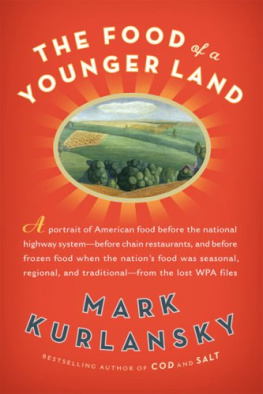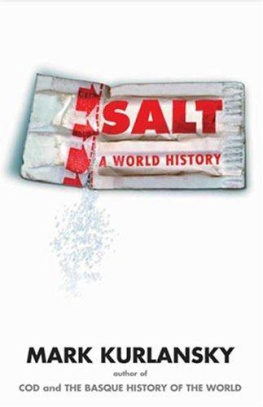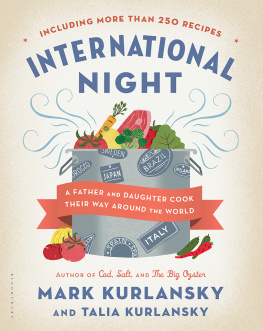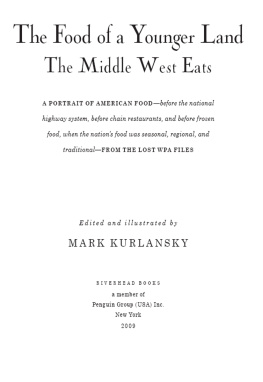Text copyright 2014 by Mark Kurlansky
Birdseye is a registered trademark of Pinnacle Foods Group LLC.
All rights reserved. Published in the United States by Delacorte Press, an imprint of Random House Childrens Books, a division of Random House LLC, a Penguin Random House Company, New York.
This work is based on Birdseye: The Adventures of a Curious Man, copyright 2012 by Mark Kurlansky, published in hardcover by Doubleday, a division of Random House LLC, in 2012.
Delacorte Press is a registered trademark and the colophon is a trademark of Random House LLC.
Visit us on the Web! randomhousekids.com
Educators and librarians, for a variety of teaching tools, visit us at
RHTeachersLibrarians.com
Library of Congress Cataloging-in-Publication Data
Kurlansky, Mark.
Frozen in time : Clarence Birdseyes outrageous idea about frozen food / Mark Kurlansky.
pages cm
Audience: Age 10 and up.
ISBN 978-0-385-74388-4 (hardback)
ISBN 978-0-375-99135-6 (library binding)
ISBN 978-0-385-37243-5 (ebook) ISBN 978-0-385-37244-2 (pbk.)
1. Birdseye, Clarence, 1886-1956Juvenile literature. 2. Frozen foods industryUnited StatesHistoryJuvenile literature. 3. InventorsUnited StatesBiographyJuvenile literature. 4. BusinessmenUnited StatesBiographyJuvenile literature. I. Title.
HD9217.U52B5753 2014
338.7664dc23
[B]
2014017840
Random House Childrens Books supports the First Amendment and celebrates the right to read.
v3.1_r1
To the memory of the too-short but good life of
Cooper Dean Stock,
a boy of curiosity and laughter
I ts easy to take for granted the food we eat today. When you open the freezer to take out a pizza or a bag of peas or a box of waffles, youre probably not thinking about who invented frozen food. But someone did, and that man was Clarence Birdseye. Some people might say that this is a book about a nerd, but it is really a book about a man who started a food revolution.
Clarence Birdseye was one of those kids who dont quite fit in. He was intensely interested in things his peers were not thinking much about. He did not care about what was hip or fashionable, and he was sometimes ridiculed for his peculiar interests. He didnt have enough money to finish college and was forced to drop out, yet he ultimately made a fortune off one of his ideas.
Although this story isnt from the headlines of today, it might sound like its happening now. A list of people who changed the world in our time would include Bill Gates, a man who got his start devising a computer program for tic-tac-toe in the eighth grade; spent most of high school and college creating other programs; dropped out of Harvard to start his own software company, Microsoft, at age twenty; and soon became the wealthiest man in the world. And Mark Zuckerberg, who started Facebook with a group of college friends. Like Gates, Zuckerberg didnt finish college and started his own business, which made him a billionaire by age twenty-three.
Twenty-first-century inventors achieve fame and fortune at a much earlier age than their nineteenth- and twentieth-century counterparts. In truth, there have always been life-changing inventions, and the inventors from a century ago were just like the young people of today. They were people who looked at what could be created and found innovative ways to make new projects happen.
When Clarence Birdseye was alive, from the late nineteenth to the mid-twentieth century, the rate at which original, life-changing inventions were being developed and sold was dazzling. These dramatic inventions included electric lights, automobiles, the phonograph, and even the airplane, as well as smaller ideas, such as portable cameras, drinking straws, Styrofoam, fountain pens, and barbed wire.
Birdseyes interest in industrial food is not surprising, as there were many before him who made their fortunes from products like flavored gelatin, dried cereal, processed cheese, or sliced bread. Making a fortune on developing a really melty fake cheese is no stranger than selling an app that takes photos of your dog in a hat for more than a billion dollars. The key to invention is simply imagining something.
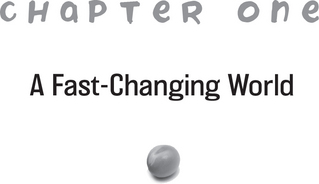
I f Clarence Birdseye hadnt been born in Brooklyn (which was not part of New York City in the 1880s) on December 9, 1886, his life might have been very different. Brooklyn was the third-largest city in the United States and one of the fastest growing. Between 1880 and 1890, the population of Brooklyn increased by more than a third, to 806,343. One of the factors that made such growth possible was refrigeration. When populations of a few hundred thousand people or more lived in a concentrated area that produced no food, it was difficult to supply and distribute the needed quantities of fresh and nutritious food every day. Once people were able to buy a few days worth of groceries and refrigerate them, population density began to rise.
A critical component of refrigeration around the world was ice generated in winter on the frozen lakes of upstate New York and New England and stored year-round in icehouses along the Hudson River. There the ice was kept insulated with sawdust until it could be shipped to cities. The storehouses supplied New York City with more than one million tons of ice every year for food and drinks.
The pleasure of enjoying iced drinks on a hot day had been a luxury for the wealthy since Roman times, but in New York City in the late nineteenth century, it became commonplace. Almost half of Manhattanites and Brooklynites stored food in their homes inside insulated boxes chilled by blocks of ice. A few people even had artificially chilled refrigerators, though at that time they were dangerous and clumsy electric machines with unpredictable motors and leaky fluids.
Birdseye was born into this world of iced drinks and refrigeration. He and other New Yorkers lived in a city where ice was used more than anywhere else in the world.
Even though Birdseye lived most of his life in the twentieth century, he spent his formative years in the late 1800s and grew up to become a nineteenth-century man. He was born at the height of the Industrial Revolution, and though he worked in an age of electronic invention, all his inventions would be mechanical, never electronic.
When Birdseye was born, the popular heroes were the inventors of the Industrial Revolution, who created that great shift from products made by hand in workshops to products made by machines in factories. He grew up in a time when industry was admired and industrializing was considered an admirable feat, as creating new technological gadgets is today.
In Birdseyes age the world was rapidly becoming industrialized, yet the food industry lagged behind and was still mostly artisanal. Not everyone had an icebox, and the preservation of refrigerated food had not been perfected. People had to rely almost exclusively on fresh produce.


